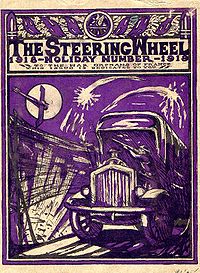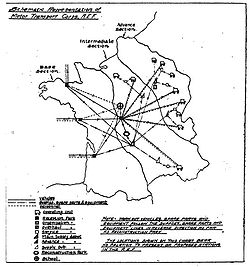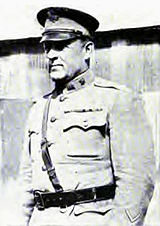_(world_war_one).gif)
Motor Transport Corps (United States Army) (World War One)
Encyclopedia
The Motor Transport Corps (M.T.C.) was formed out of the Quartermaster Corps on 15 August 1918, by General Order No. 75. Men needed to staff this new corps were recruited from the skilled tradesmen working for automotive manufacturers in the U.S.
of Lynchburg, Virginia
. Walker was chief engineer of the Pancho Villa Expedition
in 1916–17. He later was appointed governor of the Panama Canal Zone
. The deputy director was Col. Francis Horton Pope of Kansas. The M.T.C. was headquartered in Tours
during the duration of World War I
.
Excluded from this definition were:
These were to be under the control of the Ordnance Department.
 The American Expeditionary Force
The American Expeditionary Force
that deployed to France during World War I
was in need of an organization that could log, track and maintain all needed motor transportation. A school and a network of parks were set up to accomplish this.

 A permanent facility equipped for large scale rebuilding and salvage operations. A temporary park in Nevers
A permanent facility equipped for large scale rebuilding and salvage operations. A temporary park in Nevers
was relocated in July 1918 to a permanent facility in Verneuil, Nièvre
, 30 miles (48.3 km) east of Nevers. The M.T.C. Reconstruction Park covered approximately 1000 acres (4 km²) and consisted of five steel shops averaging 25000 sq ft (2,322.6 m²) each and a large warehouse for storage of spare parts. The park was staffed by three units of approximately 1,150 men each (Units 301, 302, and 303). Some labor was also supplied by German prisoners who were housed inside the Park.
Command of the park at Verneuil was assigned to Colonel Harry A. ("Bull") Hegeman, who was awarded the Distinguished Service Medal
for his involvement in the operation, in spite of the post-war accusation of mismanagement and waste there. Hegeman was a mechanical engineer from Sparta, Wisconsin
.
and later, General James Harbord
, in April 1919.
The parks were closed after the war and the Motor Transport Corps was dissolved in 1920.
Organization
The first director of the M.T.C. was Brig. Gen. Meriwether Lewis WalkerMeriwether Lewis Walker
Meriwether Lewis Walker was Governor of the Panama Canal Zone from 1924 to 1928.He graduated from the United States Military Academy at West Point in 1893. He was then commissioned in the U.S. Army Corps of Engineers....
of Lynchburg, Virginia
Lynchburg, Virginia
Lynchburg is an independent city in the Commonwealth of Virginia. The population was 75,568 as of 2010. Located in the foothills of the Blue Ridge Mountains along the banks of the James River, Lynchburg is known as the "City of Seven Hills" or "The Hill City." Lynchburg was the only major city in...
. Walker was chief engineer of the Pancho Villa Expedition
Pancho Villa Expedition
The Pancho Villa Expedition—officially known in the United States as the Mexican Expedition and sometimes colloquially referred to as the Punitive Expedition—was a military operation conducted by the United States Army against the paramilitary forces of Mexican insurgent Francisco "Pancho" Villa...
in 1916–17. He later was appointed governor of the Panama Canal Zone
Panama Canal Zone
The Panama Canal Zone was a unorganized U.S. territory located within the Republic of Panama, consisting of the Panama Canal and an area generally extending 5 miles on each side of the centerline, but excluding Panama City and Colón, which otherwise would have been partly within the limits of...
. The deputy director was Col. Francis Horton Pope of Kansas. The M.T.C. was headquartered in Tours
Tours
Tours is a city in central France, the capital of the Indre-et-Loire department.It is located on the lower reaches of the river Loire, between Orléans and the Atlantic coast. Touraine, the region around Tours, is known for its wines, the alleged perfection of its local spoken French, and for the...
during the duration of World War I
World War I
World War I , which was predominantly called the World War or the Great War from its occurrence until 1939, and the First World War or World War I thereafter, was a major war centred in Europe that began on 28 July 1914 and lasted until 11 November 1918...
.
Functions
General Order No. 75 spelled out the functions of the Motor Transport Corps as:- The technical supervision of all motor vehicles.
- The design, production, procurement, reception, storage, maintenance and replacement of all motor vehicles, and accounting for same.
- The design, production, procurement, storage and supply of Transport Corps garages, parks, depots and repair shops.
- The procurement, organization and technical training of Motor Transport Corps personnel.
- The salvage and evacuation of damaged motor vehicles.
- The homogeneous grouping of motor vehicles.
- The operation, in accordance with instruction from the proper commanding officer as to their employment, of groups of motor vehicles of "First Class".
- The preparation of plans for hauling cargo and personnel over military roads, or roads under military control will be under the control of the Motor Transport Corps.
- The procurement, supply, replacement and preliminary training before assignment to combatant organizations, of personnel for operation of motor vehicles of the "Second Class", will be made by the Motor Transport Corps.
Types of motor vehicles
General Order No. 75 also defined a "motor vehicle" as:- Bicycles
- Motorcycles
- Automobiles
- Trailers and Trucks
Excluded from this definition were:
- Tractors of the caterpillar typeTracked vehicleA tracked vehicle is a vehicle that runs on continuous tracks instead of wheels...
, designed primarily for traction purposes - Tanks
These were to be under the control of the Ordnance Department.
Wartime Operation: 1918–1919

American Expeditionary Force
The American Expeditionary Forces or AEF were the United States Armed Forces sent to Europe in World War I. During the United States campaigns in World War I the AEF fought in France alongside British and French allied forces in the last year of the war, against Imperial German forces...
that deployed to France during World War I
World War I
World War I , which was predominantly called the World War or the Great War from its occurrence until 1939, and the First World War or World War I thereafter, was a major war centred in Europe that began on 28 July 1914 and lasted until 11 November 1918...
was in need of an organization that could log, track and maintain all needed motor transportation. A school and a network of parks were set up to accomplish this.
School
All M.T.C. and some non-M.T.C. personnel were to attend training programs to learn operation and repair of motor vehicles. Some courses offered:- ConvoyConvoyA convoy is a group of vehicles, typically motor vehicles or ships, traveling together for mutual support and protection. Often, a convoy is organized with armed defensive support, though it may also be used in a non-military sense, for example when driving through remote areas.-Age of Sail:Naval...
driving - Rules of the road
- Oiling, greasing and cleaning
- Map reading
- Motorcycle operation and repair
- Practical shop work
- Repairs of solid and pneumatic tires
- Oxy-acetylene weldingOxy-fuel welding and cuttingOxy-fuel welding and oxy-fuel cutting are processes that use fuel gases and oxygen to weld and cut metals, respectively. French engineers Edmond Fouché and Charles Picard became the first to develop oxygen-acetylene welding in 1903...
Parks

Reception Parks
Vehicles were unloaded, uncrated and assembled at these parks, then assigned a registration card and markings. Detailed records were kept on each vehicle's whereabouts and conditions. Vehicles and spare parts collected in these parks awaited assignments to specific army units as requested. With the exception of the highest ranking officers, no officer had his own personal car during the war. A large reception park was located in St. Nazaire.Service Parks
Designed to make repairs not requiring much time or heavy equipment, these mostly mobile workshops carried a limited stock of spare parts and were mainly assigned to combat zones. Because of their temporary and mobile nature, the service parks were often operating in the open, under canvas, or in any shelter found to be available.Overhaul Parks
These parks were to occupy permanent or semi-permanent structures for basic vehicle maintenance and repair. They were to be located 30 miles (48.3 km) behind the fighting zone (40 miles if behind a "thinly held sector"). When the cost of a repair exceeded 30% of the first cost of the vehicle, they were to be sent to a reconstruction park for salvage.Reconstruction Park

Nevers
Nevers is a commune in – and the administrative capital of – the Nièvre department in the Bourgogne region in central France...
was relocated in July 1918 to a permanent facility in Verneuil, Nièvre
Verneuil, Nièvre
Verneuil is a commune in the Nièvre department in central France.-Demographics:At the 1999 census, the population was 329. On 1 January 2006, the estimate was 332.-References:*...
, 30 miles (48.3 km) east of Nevers. The M.T.C. Reconstruction Park covered approximately 1000 acres (4 km²) and consisted of five steel shops averaging 25000 sq ft (2,322.6 m²) each and a large warehouse for storage of spare parts. The park was staffed by three units of approximately 1,150 men each (Units 301, 302, and 303). Some labor was also supplied by German prisoners who were housed inside the Park.
Command of the park at Verneuil was assigned to Colonel Harry A. ("Bull") Hegeman, who was awarded the Distinguished Service Medal
Distinguished Service Medal (United States)
The Distinguished Service Medal is the highest non-valorous military and civilian decoration of the United States military which is issued for exceptionally meritorious service to the government of the United States in either a senior government service position or as a senior officer of the United...
for his involvement in the operation, in spite of the post-war accusation of mismanagement and waste there. Hegeman was a mechanical engineer from Sparta, Wisconsin
Sparta, Wisconsin
Sparta is a city in and the county seat of Monroe County, Wisconsin, United States, along the La Crosse River. The population was 9,522 at the 2010 census.-Notable people:*William Hawley Atwell, U.S. District Court Judge in Texas*Larry Baumel, NASCAR...
.
Post War: 1919–1920
According to the M.T.C. Reconstruction Park newsletter "Let's Go", the park was visited by General John J. PershingJohn J. Pershing
John Joseph "Black Jack" Pershing, GCB , was a general officer in the United States Army who led the American Expeditionary Forces in World War I...
and later, General James Harbord
James Harbord
James Guthrie Harbord was a Lieutenant General in the United States Army and President and Chairman of the Board of RCA....
, in April 1919.
The parks were closed after the war and the Motor Transport Corps was dissolved in 1920.
External links
- World War IWorld War IWorld War I , which was predominantly called the World War or the Great War from its occurrence until 1939, and the First World War or World War I thereafter, was a major war centred in Europe that began on 28 July 1914 and lasted until 11 November 1918...
- U.S. Army Transportation Corps
- U.S. Army Transportation MuseumU.S. Army Transportation MuseumThe U.S. Army Transportation Museum is a United States Army museum of vehicles and other transportation-related equipment and memorabilia. It is located on the grounds of Fort Eustis, Virginia, in Newport News, on the Virginia Peninsula.-History:...
- The U.S. Army Quartermaster Museum in Fort Lee, Virginia
- Francis Horton Pope—Arlington National Cemetery Website
- United States Army Quartermaster Corps
- http://www.archive.org/details/americasmunitio01deptgoog

